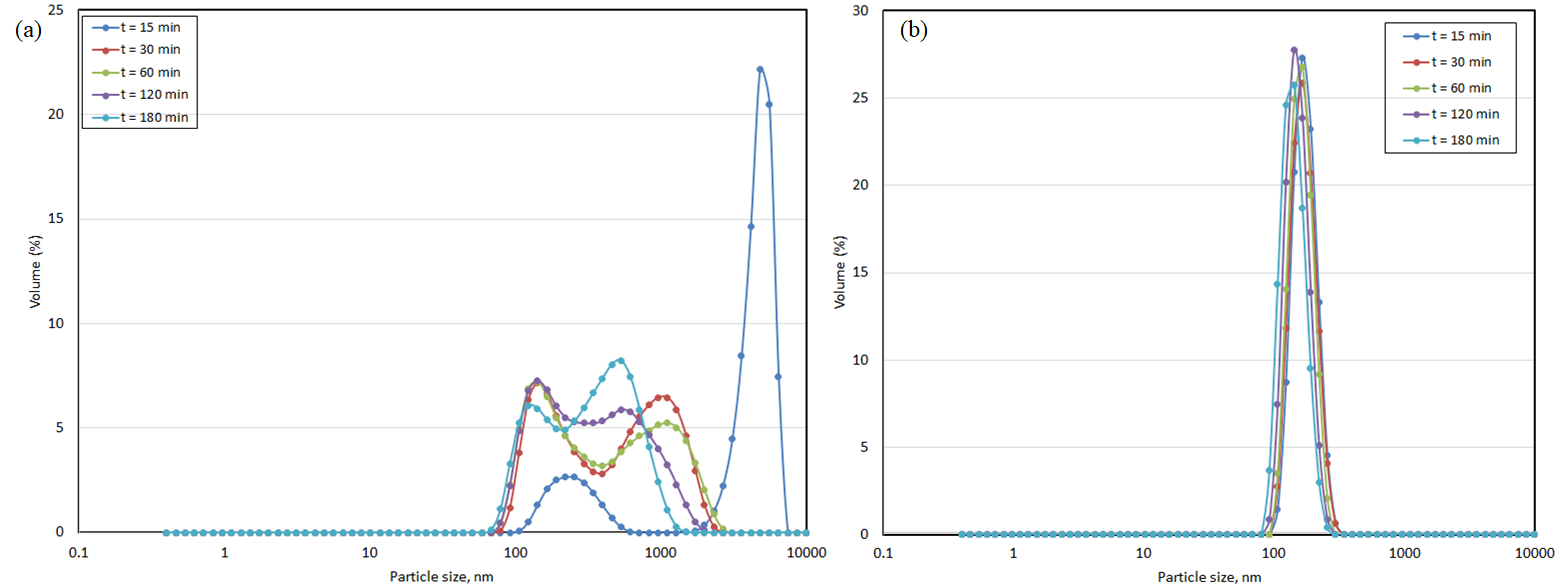(170h) Nanoparticle Suspension in the Viscous Fluid Using High Shear Mixing
AIChE Annual Meeting
2020
2020 Virtual AIChE Annual Meeting
North American Mixing Forum
Advances in Experimental Investigation of Mixing Processes
Tuesday, November 17, 2020 - 9:30am to 9:45am
In commercialized product such as health and personal care, coating, paints and rubber products, etc. nanoparticle incorporation and their cluster breakup is very important for performance improvement and stabilization. Incorporation of nanoparticles into liquid leads to the agglomeration of the primary particles, and therefore, the de-agglomeration of these clusters needed to be achieved as fine as possible in dispersion. For a high and intense rate of mixing hence a rotor or impeller, together with a component that is known as a stator, or many rotors and stators together forming a group, is used either in a tank containing the solution that is to be mixed or in a pipeline through which the solution passes, to invoke intense lateral mixing of the two phases which results in shear, hence the high shear mixer. High shear mixers (HSMs), characterized by high shear and energy dissipation, and compromised of a moving (Rotor) and stationary (Stator) parts. HSMs are used in a wide variety of applications such as nanoparticle synthesis and dispersion, fine size reduction, emulsions, grinding, and homogeneous mixing in various industries like petrochemical, cosmetics, food, and pharmaceutical. High energy dissipation in HSMs responsible for the breakage of nanoparticle clusters and however, fines structures as aggregates cannot be broken further due to the presence of stronger intermolecular force. This study was performed to investigate the dispersion of nanoparticles in viscous fluids and also to study the effect continuous phase viscosity on the uniform blending of nanoparticles in a high shear mixer.
Materials and method
Agglomerated nanoparticles Aerosil® 200 having specific surface area 175–225 m2/g with a SiO2 content of > 99.8% was used as agglomerated fumed particles in the present study, Evonik industries make. Rheology modifier, anti- settling, and sagging agents are the main properties of fumed silica. Aerosil® 200 are generally used in products like paints, printing inks, adhesives, cable gels, plant protection, sealants, and coatings. The tapped density of Aerosil® 200 was »50 g/l with primary particle size diameter of 12 nm. Fumed silica was dispersed in different continuous media such as millipore water and glycerol-water (with different viscosities as 10, 50 and 100 mPa.s) solutions. Glycerol was purchased from the local market. Experiments were run at a solid loading of 1 wt% in the different continuous phase, and the temperature was maintained at 20±3 °C throughout the study. Fluko make batch high shear mixer (FM30-D) was used with different stator assembly such as mesh and disintegrated head type in the present work at different rotor speed. Samples were taken at different intervals of time, and particle size distribution was measured using Malvern make model Nano–ZS90. The reflective index (RI) of Aerosil particles was used as 1.46+0.1i. Rheological measurements were carried out using Anton-Paar TwineDrive Rheometer, MCR 702. Separate experiments based on calorimetric techniques were performed to calculate the power input. Further, different geometries of HSMs were used at different rotor speed such as 4000 rpm, 6000 rpm, and 8000 rpm. Dispersion morphology was carried out using a scanning electron microscope (SEM) and transmission electron microscopic (TEM).
Result and discussion
Bi-modal distribution of nanoparticles, in water-based dispersion, based on the volume of fines generated was observed over a periodic interval of time. It suggested that the predominated mechanism for the breakup of de-agglomeration of Aerosil 200 nanoparticles was erosion, i.e. smaller aggregates were chipped of from the surface of larger agglomerates due to presence of smaller and larger agglomerates in the final dispersion. Similar observations were made by Padron et al. (2018) for the de-agglomeration of Aerosil 200V nanoparticles (a densified version of Aerosil 200) in an in-line HSM. However, the size of fines (<1 micron) and coarse (>1 micron) in their study was much higher than that was found in the present study. Further, the volume of fines generation increased with an increase in the processing time; therefore, the volume fraction of fines generation is a function of time. The average particle size (Z-average) was found fairly constant throughout the dispersion process in water-based dispersion (ranging from 150 to 250 nm). However, Z-average decreased, and the volume of fines generation increased with an increase in the rotor speed. In the case of dispersion of nanoparticles in an aqueous solution of glycerol at different viscosities, it was found that the volume fraction of fines produced in glycerol-based dispersion increased with an increase in dispersion time and further, Z-average particle size was less as compared to the water-based dispersion. Further, as the viscosity increased, the average particle size of fines generated decreases. Dispersion of particles in water and 100 mPa.s glycerol solution in mesh type stator head can be seen in Figs. 1(a) and 1(b), respectively.
The dispersion was also studied for glycerol having 10 and 50 mPa.s viscosity at different rotor speeds (4000 rpm and 6000 rpm) and stator heads (mesh and disintegrated type). Further, rheological characterization of dispersion was investigated at different time intervals, and temperatures and Newtonian behavior was found. Scanning characterization further validated the argument of the dispersion process in HSMs as erosion. Calorimetric analysis was performed to calculate the power draw at different operation conditions.
